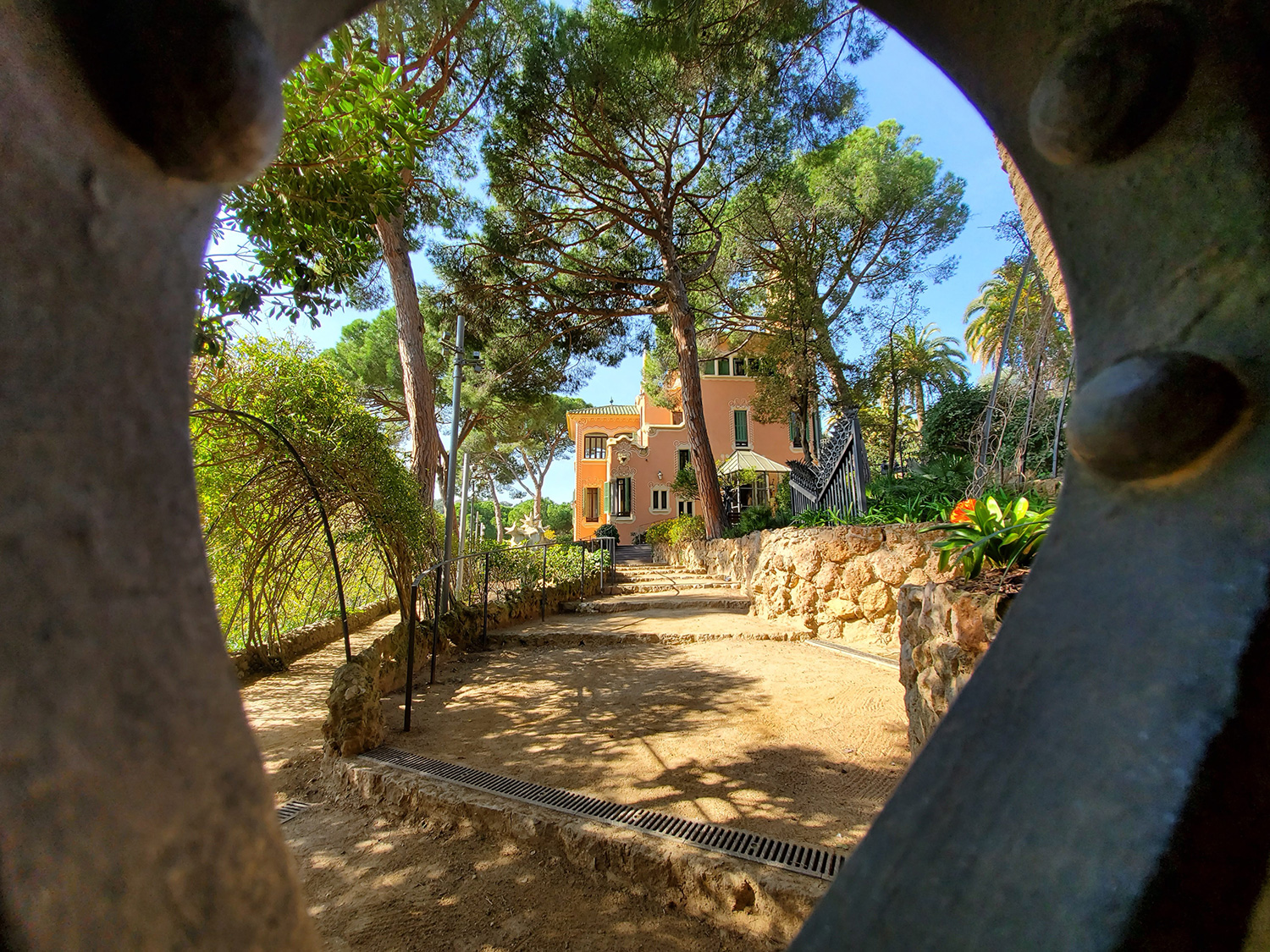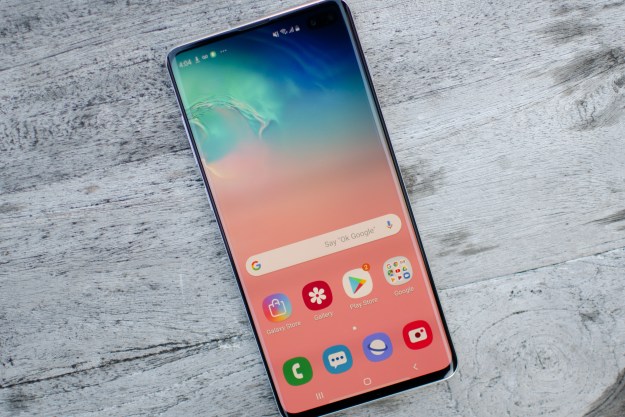
- Strong performance
- Great battery life
- Versatile triple cameras
- Gorgeous, expansive HDR10+ screen
- Clean, smart OneUI software
- Slim bezels means accidentally interacting with the screen
- Slow wired charging
Want a great deal on a smartphone this holiday? Check out our best Black Friday smartphone deals.
It’s the details.
The light that circles around the selfie camera when the phone tries to scan for a face; the sudden realization there’s no need for a dongle because of the headphone jack; the software that’s easier to reach with one hand.
The Galaxy S10 Plus is Samsung’s best smartphone yet, and not just because of its hardware. It’s the slick and thoughtful software that ties it all together for an impressively polished experience.
I generally go back to a Google Pixel after reviewing a new phone, but the Galaxy S10 Plus will be staying in my pocket for some time. It is priced at $1,000 though, making it the most expensive phone in the history of the Galaxy S-line. Keep in mind there’s also the smaller Galaxy S10 ($900), as well as the Galaxy S10e ($750), which we’ll be looking at soon if you want slightly more affordable options from Samsung (there are also plenty of great phones that cost far less if you’re on a budget).
So, is the S10 Plus worth it?
Spectacular display
Clean and elegant are the first words that pop into my head after looking at the S10 Plus. The differences over last year’s S9 Plus are small, but impactful, drastically altering the design language of the phone.
The bezels around the screen look razor thin thanks to the new “hole-punch” Infinity-O display. A laser cuts out a small hole from the screen without damaging pixels, allowing the camera to float at the top like a hole-punch in a piece of paper. It looks better than the notch design present in a lot of phones from 2018, and while a true full-screen experience would be ideal — like the Oppo Find X — Samsung’s approach looks great.
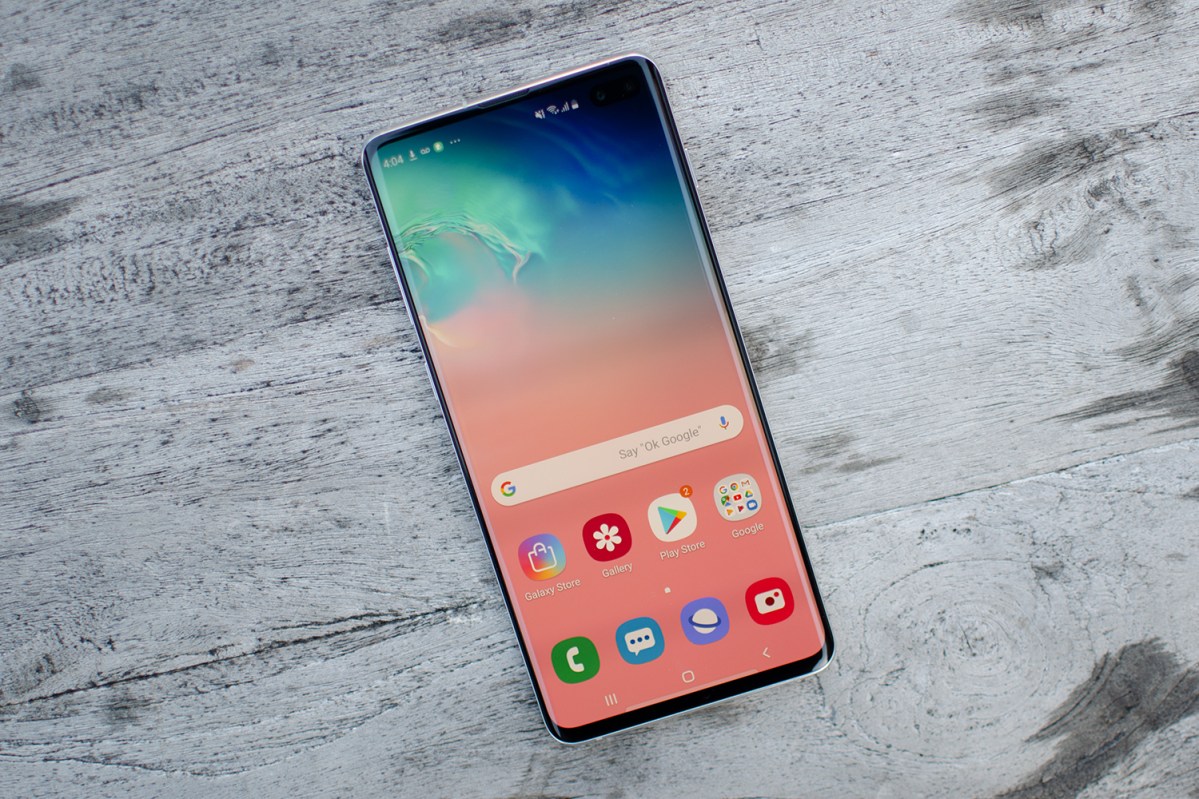
The status bar is bigger now, but most apps look good on the thin-bezel screen in portrait orientation. Swap to landscape, and the screen looks a little funky. Third-party apps don’t wrap around the hole-punch camera but use a black bar that ruins the symmetry of the bezels. You end up with a thicker bezel on the side with the selfie camera than the other. It’s not a deal breaker, but it’s something you notice.
The screen is the big reason to buy the S10 Plus.
It’d be nice if full-screen apps adapt to make use of the screen space. YouTube, for example, lets you watch a full-screen video that goes edge-to-edge on the S10 Plus — which looks more immersive — but Netflix has yet to add this support.
The S10 Plus has 6.4-inch screen and uses Samsung’s new “Dynamic AMOLED” display technology. It’s the first screen to be HDR10+ certified, which means you’ll see sharper details with incredible color accuracy. Indeed, the colorful screen is beautiful, and the Wide QHD+ (3,040 × 1,440) resolution ensures everything looks crisp (though by default the screen is set to Full HD+).
The screen is the big reason to buy the S10 Plus. Its large size is perfect for consuming movies and shows, and it helps that the stereo speakers sound great. It feels like a movie theater that can fit in your pocket.

The new Dynamic AMOLED display looks a little warm, something I only noticed when comparing it to the Galaxy S9 Plus. That may be because the screen natively reduces blue-light exposure by 42 percent, a feature that is certified by TÜV Rheinland, an independent product testing company. Blue light can be harmful to your health as it can affect sleep, so it’s nice to see this baked in.
That said, the beautiful thin bezels cause problems. I’ve never accidentally activated a phone more than the Galaxy S10 Plus. Its large size and 93.1-percent screen-to-body ratio means I’ve frequently sent the Facebook thumb in messaging threads because my palm touches the edge of the screen. The vision of achieving a full-screen design has its drawbacks, and Samsung needs to put more effort into improving its palm rejection technology.
New fingerprint sensor, elegant design
Flip it around, and the back of the S10 Plus is the cleanest-looking Samsung phone in existence. It has three cameras now, placed horizontally like on the Galaxy Note 9. Aside from the Samsung logo, there’s nothing to clutter the design.
Wait, so where did the fingerprint sensor go? It’s under the display! It’s an embedded ultrasonic fingerprint scanner which captures 3D contours of thumbs and fingerprints. This offers better anti-spoofing measures than traditional optical sensors, which rely on an image of a fingerprint. There are machine-learning algorithms in place to prevent spoofing, and the fingerprint data never leaves the device.
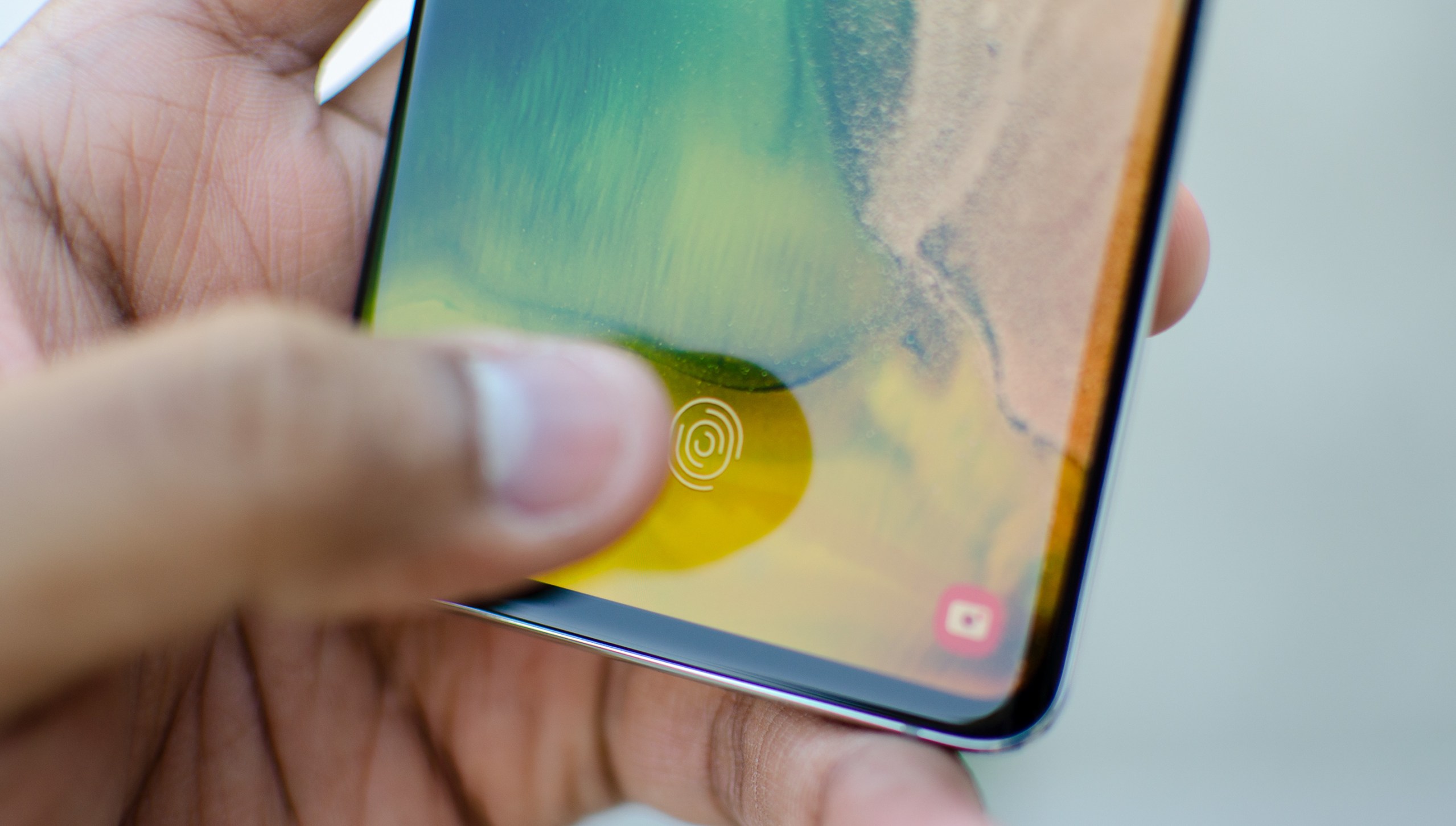
Like the fingerprint sensor on the back of phones, you do need to precisely place your thumb or finger on the right spot — at the bottom of the S10 Plus’ screen — to unlock the phone. It takes some getting used to, but it’s the best in-display fingerprint sensor I’ve tested. I’d love if all phones switched to this design. It’s not the quickest, but it’s more convenient.
If you set up the face unlock option, though, it’s near impossible to use the fingerprint sensor because the phone unlocks so quickly. But face unlock is not as secure — it can be triggered with just a picture of your face. I recommend going to Settings > Biometrics and security > Facial recognition and toggle off Faster recognition, which makes the unlocking speed a little slower, but it won’t be as easy to spoof the technology. You can use the secure fingerprint scanner to log into sensitive apps and authenticate payments through Samsung Pay, though it’d have been nice to have a secure face unlock option like Apple’s Face ID as an alternative.
The S10 Plus’ unwieldy size is a sacrifice I’m willing to make for the beautiful display.
The S10 Plus is tall and difficult to use one-handed. I wish the volume rocker and power button were a little farther down, as it would make it easier to reach. Handling the 6.1-inch Galaxy S10 is more manageable, so it is the far better option for people who want a smaller phone (the new Galaxy S10e is technically the smallest, at 5.8 inches, but that’s a different product). Still, the S10 Plus’ unwieldy size is a sacrifice I’m willing to make for the beautiful display.
The aluminum frame isn’t completely rounded, offering a good grip when holding the phone — important as both the front and back are completely glass (Gorilla Glass 6 on the front, Gorilla Glass 5 on the back). Encasing it to protect the phone from cracks is a good idea. Speaking of the metal used in the body of the phone — it’d have been nice to see stainless steel here like Apple used on the iPhone XS and XS Max instead of aluminum.
I should note there are two special editions that use a different material. The 512GB and 1TB Galaxy S10 Plus come with a glass front and a white or black ceramic back plate to commemorate the 10-year anniversary of the Galaxy S-series. These phones feel far more luxurious than the all-glass models, offering better durability and scratch resistance. They’re worth considering since you’re already spending $1,000, but the 128GB of storage in the base model is more than enough for most people.
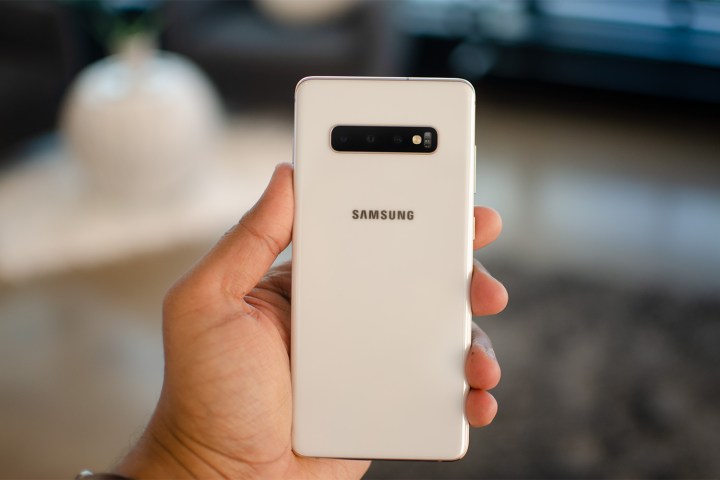
I’m happy to see Samsung still including the headphone jack for those holding on to their 3.5mm earbuds and headphones. There are moments when I’ve forgotten my wireless earbuds (or they’re not charged) and I can’t find my dongle, so I’ve been unable to listen to music on other phones, but that’s not a problem with the S10 Plus. You can even charge the phone via the USB-C port and listen to music at the same time!
Powerful specs paired with Samsung’s best software experience
The Galaxy S10 Plus is powered by Qualcomm’s Snapdragon 855 processor, which is the flagship chipset that powers most high-end Android phones this year. There’s a massive 8GB of RAM inside, except for the 1TB Galaxy S10 Plus model, which comes with a whopping 12GB of RAM. As mentioned, there’s 128GB of internal storage, but a MicroSD card slot is present in case you need more space.
What the Galaxy S10 Plus has — and the smaller S10 lacks — is a vapor chamber cooling system to keep the phone from overheating while you perform intensive tasks, like heavy gaming. It means the phone should deliver better performance, but we haven’t tested the smaller S10 yet to see how much of a difference it makes. The Galaxy S10 Plus ran cool in my time of use, though it did get a little warm after using the camera non-stop for 15 minutes straight.
You shouldn’t expect performance issues on this phone. Moving around the Android 9 Pie operating system is snappy and fluid, and games like PUBG: Mobile and Alto’s Odyssey run flawlessly.
Here are our benchmark results:
- AnTuTu 3DBench: 346,283
- Geekbench 4 CPU: 3,361 single-core; 10,110 multi-core
- 3DMark Sling Shot Extreme: 4,700 (Vulkan)
The AnTuTu score is among the highest we’ve ever recorded on a smartphone (higher than the iPhone XS Max), only bested by the Xiaomi Mi 9, which has the same Snapdragon 855 chip. The iPhone XS Max does beat out the S10 Plus in Geekbench scores, though. Either way, this phone is a beast and it will run anything and everything you want.
Complimenting this stellar performance is Samsung’s new One UI interface layered over the latest version of Android. It looks good and is more intuitive as it places crucial interface elements toward the bottom of the screen for easy access. I also am a fan of the darker themes to help protect my eyes when using the phone at night.
This phone is a beast and it will run anything and everything you want.
There are some neat little touches, like how a light circles the hole-punch camera when you swap to selfie mode or when the camera is trying to find your face to unlock the phone. The software is also deeply customizable — you can completely get rid of the traditional Android navigation bar if you want, for example — affording everyone the option to personalize their phone. The software is a big improvement; barring the Google Pixel 3 and the OnePlus 6T, it’s my favorite interface on a phone.
That said, while it’s nice to see the latest version of Android here, updates will inevitably be one of the biggest issues with Samsung’s smartphones. The unlocked version of the Galaxy S9 only just got Android 9 Pie — six months after Google released it, which is disappointing. You won’t see this delay on Google’s Pixel phones or the iPhone.
The S10 Plus can’t connect to 5G networks as it doesn’t have the required Qualcomm X50 modem inside. It’s an opt-in feature, and Samsung has decided to make a special-edition Galaxy S10 5G instead, which will be able to connect to the next-generation mobile network. However, U.S. carriers are still deploying 5G, so don’t expect to see nationwide service soon.
Bixby
Ironically, the one button that’s easily accessible is the one I dislike. Yes, it’s the dreadful Bixby button that activates Samsung’s virtual assistant. I haven’t found much of a reason to use Bixby, though it has performed well the times I have asked it to set reminders or asked it queries. I’ve grown used to using Google Assistant — which is also available on the phone — and it often gives me better results.

Thankfully you can remap the Bixby button, though it’s a bit limited. You can set the button to open another app, for example, but a double press will still open Bixby (and vice versa). The disappointing news is you can’t use it to launch Google Assistant natively, but there is a workaround if you’re willing to install a third-party app.
New for the S10 Plus is a feature called Bixby Routines, I like using it. It works like IFTTT, which lets you set up different profiles for your phone based on certain triggers, like when you arrive home or connect to your work’s Wi-Fi. I’ve set it to turn my phone’s sound on when I arrive home, and to swap to vibrate-only at work. It’s a neat and powerful feature, but I doubt Bixby’s “A.I.” has much to do with it.
Triple cameras
One of the more noticeable changes over last year’s S9 Plus is the addition of a third camera in the S10 Plus. The other two cameras are the same — a standard 12-megapixel lens with a variable f/1.5 to f/2.4 aperture (which Samsung first debuted last year) is paired with a 12-megapixel telephoto lens with a f/2.4 aperture. The extra camera is a 16-megapixel ultra-wide-angle lens with a f/2.2 aperture.
This makes the camera versatile. Want a close-up? Use the telephoto lens for 2x optical zoom. Need to capture a group picture or a landscape? Swap to the ultra-wide-angle lens. Transitioning between these is fast and fluid — either tap on the respective lens icons or just pinch in or out within the camera viewfinder and the phone will automatically swap to the relevant lens. The S10 Plus joins the ranks of the Huawei Mate 20 Pro and the LG V40 ThinQ with triple camera lenses in the same type of setup.
Photos captured in the daytime are detailed and colorful. There’s good HDR, so photos are never blown out or underexposed. The cameras tend to lack contrast however, so photos can look washed out.
In low-light environments, the Galaxy S10 Plus holds its own, but the lack of any night mode — as seen on the Pixel 3 with Night Sight or the Mate 20 Pro with Night mode – means photos fall short. You’re best off using the standard lens in low light with its wider aperture, as the telephoto and wide angle lenses produce muddier images in these conditions.
While the triple-camera setup doesn’t make the Galaxy S10 Plus the best camera phone, the wide-angle lens works great. While on vacation in Lisbon I used the wide-angle lens to capture the narrow alleyways of the city. It’s a ton of fun to play with, despite some distortion and lack of detail in some images.
While the triple-camera setup doesn’t make the Galaxy S10 Plus the best camera phone, the wide-angle lens works great.
What’s new with the camera software? Samsung has expanded Scene Optimizer’s shooting modes to 30 (that’s 10 new scenes, ranging from dog, cat, shoes, and baby). Scene Optimizer uses artificial intelligence to automatically detect scenes like sunsets or people and attempts to adjust your photo to what it thinks looks best. I left it on for most of our testing, and it did help images pop, but can also lead to oversaturation at times.
My favorite feature is Shot Suggestions, which suggests straightening the camera if you’re tilting it, while also suggesting better compositions. All you need to do is point the camera at the recommended “Best Shot” and the phone will automatically take the photo. It eliminates the need to tap the shutter button completely. The compositions it suggests are usually solid, though a few poor choices slip in.
Samsung’s Portrait Mode is called Live Focus, which is where a blur effect is added behind a subject. Live Focus photos aren’t quite as good as what we’ve seen from the Google Pixel 3 or the Nokia 9 PureView — details aren’t as strong in low light and the blur effect can look a little messy sometimes. I do like the new Live Focus mode called Color Point, which keeps the subject in color while making everything else black and white. It does a surprisingly good job maintaining color on a subject, offering a cool effect.

What’s more impressive is the camera’s capability to record HDR videos in 4K. Videos have a cinematic look to them and they’re quite colorful. There’s also a “Super Steady” mode for when you’re moving around a lot and want to capture stable footage — it’s impressive how well it works, but there are stipulations on how these modes can be used. You can’t shoot 4K HDR at 60 frames per second, for example, just at 30FPS. You can’t use Steady Shot if you’re shooting in HDR, so you’ll need to turn it off, and it only works with the main lens. These settings should automatically change when you tap on different shooting modes to make it easier on the person using the phone.
Up front, the S10 Plus has a 10-megapixel lens with a f/1.9 aperture, and it can also capture 4K UHD video. The S10 Plus differentiates here from the smaller S10 with an additional camera on the front. It’s an 8-megapixel lens with a f/2.2 aperture, and it’s purely there to capture better depth data. It does capture better Live Focus selfies than last year’s Galaxy S9 Plus, but we’ll need to test the smaller Galaxy S10 to see how big a difference it makes. It also enables better animations for Samsung’s AR Emojis, but that’s not high praise. They still look sub-par compared to Apple’s Memoji, and the AR Emojis always get my skin color wrong.
Big battery
Another reason to buy the Galaxy S10 Plus is for its 4,100mAh battery. Take a look at our Galaxy S9 and Galaxy S9 Plus reviews and you’ll see I complained about battery life on both phones, as they barely got me through a full work day with medium to heavy use. This has been remedied, at least on the S10 Plus. Through heavy work days at Mobile World Congress 2019, the phone only once went under 15 percent — and that was by 10:30 p.m.
With medium to heavy use, expect a full, solid day from morning till night.
With light use, this phone can go two days, but with medium to heavy use, expect a full, solid day from morning till night. The phone lasted for 12 hours and 40 minutes in our standard video playback battery test, with the screen at max brightness on Wi-Fi. That’s the best score I’ve seen so far, but that’s largely because we only just started using this format. The smaller Galaxy S10 is close at 10 hours and 50 minutes.
The S10 Plus has an extra trick up its sleeve — it can wirelessly charge other Qi-enabled products through a new feature called Wireless PowerShare. It’s something Huawei first deployed in the Mate 20 Pro (called Reverse Wireless Charging). Place another Qi-enabled product — like an iPhone XS or Samsung’s own Galaxy Buds’ charging case — on the back of the phone, and it will recharge by sapping energy from the S10.
It’s not the fastest method to recharge some of your devices, but it works well. I recharged my Samsung Galaxy Watch Active from 34 percent to 54 percent in 20 minutes, and the Galaxy S10 Plus’ battery only dropped from 92 percent to 88 percent. It’s perfect for when you’re in a pinch.
The phone still only supports Qualcomm’s Quick Charge 2.0, so it will take some time to recharge with the charging cable in the box. For me, it took about an hour and 45 minutes to recharge the phone from zero percent using the included charging cable and adapter. Phones like the Razer Phone 2 support Quick Charge 4+, which helps juice up massive batteries in a relatively short time (it only took us a little more than an hour to recharge its 4,000mAh battery), so Samsung is lagging here.
Price, availability, and warranty information
The Galaxy S10 Plus starts at $1,000 for the 128GB storage option. It’s available now from carriers and retailers around the world.
Samsung offers a standard one-year limited warranty that covers manufacturer defects, and not much more.
If you want discounted options, you can look at our recommendations for the best smartphone deals and Samsung Galaxy deals.
Our Take
Samsung’s Galaxy S10 Plus doesn’t have the best camera, but its beefy battery, stunning display, powerful performance, and thoughtful software help make it the best phone around.
Is there a better alternative?
Yes. If you want a smaller version of the Galaxy S10 Plus without compromising on its features, nab the Galaxy S10. It’s $900 and only lacks a vapor chamber cooling system and the secondary front camera. If you want to know more, you can also look at our comparison of the Samsung Galaxy S10, Galaxy S10 Plus, Galaxy S10e, and Galaxy S10 5G.
Other Android options include the Samsung Galaxy Note 10 Plus, if you want a larger phone. You can even compare the two by reading our piece on the Galaxy Note 10 Plus and Galaxy S10 Plus. If you want a more affordable phone, the OnePlus 7 Pro is also a good choice.
Apple’s iPhone range has been updated. The most comparable is the iPhone 11 Pro and Pro Max. They’re great phones with even better cameras and excellent performance.
How long will it last?
The Galaxy S10 Plus is protected by Gorilla Glass 6, which should be tough enough to withstand a few drops, but we suggest grabbing a case. The phone is also IP68 water resistant, so it can be submerged underwater up to 1.5 meters for 30 minutes.
Expect the phone to last three to four years, if not more. It’s likely the battery will start to deteriorate by then, which may force you to upgrade.
Should you buy it?
Yes. If you’re looking for a new flagship Android phone with a big screen, the Galaxy S10 Plus is the phone for you.
Editors' Recommendations
- Best Samsung Galaxy S22 deals: Save big on unlocked models
- A surprise phone just beat the Galaxy S24 Ultra in a big way
- Having Galaxy S24 Ultra camera issues? A fix may be coming soon
- Best Samsung Galaxy deals: S24, Buds, Watches and more
- Have a Samsung Galaxy S23? Don’t update your phone to One UI 6.1








